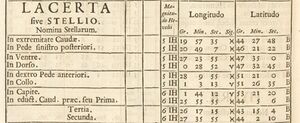Stellio
Hevelius, who invented the constellation Lacerta, gave it the alternative name Stellio in their star catalogue and star chart.
Etymology and History
Latin "Stellio", literally "star lizard", derives from "stella" (star). It designates a newt, an olive-green lizard with spotted back, typically found in the rocky areas around the Mediterranean. It is also known as "stellion" or "rock agama"; scientific name is Stellagama Stellio of the family of the Agamidae.
Mythology
In the introduction of their atlas, Jan and Elizabeta Hevelius claim that they have named this region after a lizard because the lizard is squeezed into such a narrow gap between existing constellations that no larger animal could fit there.[1] It is not preserved why they applied an alternative name here, "Lacerta sive Stellio" (The Lizard or the Stellion), but it might be a pun as there are real animals called "star lizards" while they formed the image of a lizard out of stars.
IAU Working Group Star Names
The name was discussed and approved by the IAU WGSN in 2024. As this star is ..., the WGSN chose ... (not to apply/ to apply the name to a neighbouring star/ to ...) in the IAU-CSN.







